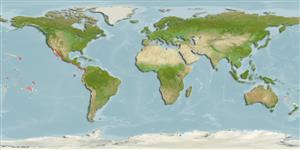>
Blenniiformes (Blennies) >
Dactyloscopidae (Sand stargazers)
Etymology: Gillellus: Theodore Nicolas Gill (1837-1914) researcher of abyssal fishes and systematics (Ref. 45335).
More on author: Gilbert.
Environment: milieu / climate zone / depth range / distribution range
Ökologie
seewasser demersal; tiefenbereich 5 - 140 m (Ref. 37955). Tropical
Eastern Central Pacific: Gulf of California to Colombia, including the Galapagos and other offshore islands.
Size / Gewicht / Alter
Maturity: Lm ? range ? - ? cm
Max length : 5.2 cm TL Männchen/unbestimmt; (Ref. 11482)
Inhabits sandy bottoms (Ref. 11482). Feeds on small fishes and invertebrates (Ref. 11482). Minimum depth reported from Ref. 11482.
Life cycle and mating behavior
Maturities | Fortpflanzung | Spawnings | Egg(s) | Fecundities | Larven
Allen, G.R. and D.R. Robertson, 1994. Fishes of the tropical eastern Pacific. University of Hawaii Press, Honolulu. 332 p. (Ref. 11482)
IUCN Rote Liste Status (Ref. 130435)
Bedrohung für Menschen
Harmless
Nutzung durch Menschen
Tools
Zusatzinformationen
Download XML
Internet Quellen
Estimates based on models
Preferred temperature (Ref.
123201): 17.2 - 28.9, mean 24.6 °C (based on 126 cells).
Phylogenetic diversity index (Ref.
82804): PD
50 = 0.5010 [Uniqueness, from 0.5 = low to 2.0 = high].
Bayesian length-weight: a=0.00389 (0.00180 - 0.00842), b=3.12 (2.94 - 3.30), in cm total length, based on all LWR estimates for this body shape (Ref.
93245).
Trophic level (Ref.
69278): 4.0 ±0.62 se; based on food items.
Fishing Vulnerability (Ref.
59153): Low vulnerability (10 of 100).
